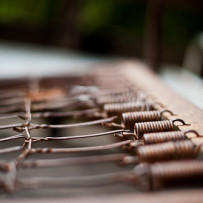Minutes from the July 09 Oneironauticum

On Monday, July 27, Dreamers Polly, Elizabeth, Kat, Emily, Amanda, Coco, and yours truly, Jennifer, gathered at Elizabeth’s beautiful house perched high on a hill with sweeping views of Marin.
We spent some time talking about the phases of sleep and the kinds of dreaming that happens in different dream states. People sleep in cycles of approximately 90 minutes (it varies individually), usually five or six cycles a night. The phase of slipping into sleep, when alpha waves (the steady mental idling of the mind that signals awake awareness) slow down to theta waves is called hynagogia. That’s when you get those weird hallucinogenic visions and when your body involuntarily kicks or starts (those are called myoclonic jerks). Then stage two sleep sets in. This is the baseline of sleep, accounting for 45 – 55% of a normal night’s sleep. Body functions slow down and muscular activity (measured by EMG) decreases greatly. Stages three and four usually get grouped together and called slow wave sleep. In those stages, brain waves slow down even more, all the way down to delta waves. Parasomnias like sleep walking, bed wetting, or night terrors happen most often in this stage. Then there’s stage five, or REM sleep. Researchers used to think that dreaming only happened in REM, but now they realize that’s not exactly true. However, people in sleep labs remember REM dreams considerably more often and reliably than they do any other dreams. Finally, there’s the state of passing from dream into a state of wakefulness. That’s called hypnopompia. Actually, it doesn’t usually get called a sleep state, but I have the best dreams there, so I tend to add it in. The time we spend in each stage changes throughout the night. The longer you sleep, the more time you spend in REM. That makes for a simple equation: sleep more and you’ll remember more dreams.
After talking about sleep stages, we prepared our kava kava. First I soaked the powdered kava in cold water for half an hour. I made a strong brew, two parts water to one part kava. A weaker brew might have a tablespoon of kava to a cup of water. Vary amount depending on desired strength. Then I put water and kava both into a blender and blended on high for a couple minutes. Finally, I strained the mix to get the powder out. It took several strainings and still our brew tasted powdery. I like the taste of kava and the slight numbing on the tongue, but people sometimes add other liquid to the blending stage (try coconut water) to improve the flavor.
The majority of us piled into several beds pushed together. Both Polly and I had difficulty falling asleep, perhaps due to the potency of the brew. However, in the morning we were also the two who best remembered any dreams. Reports from remote participants have varied quite broadly about the efficacy of the kava.
